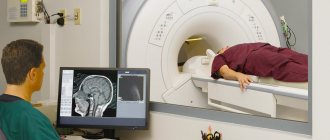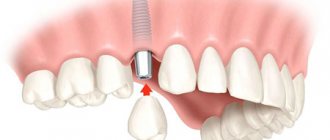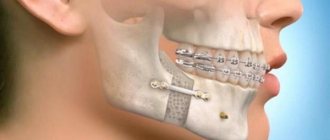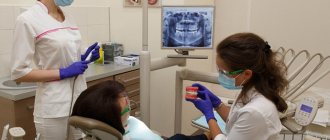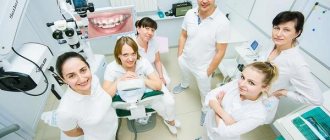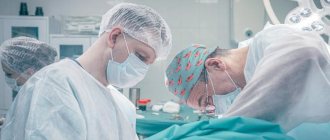Author of the article: Kryukov Andrey Vladimirovich
Chief physician. Doctor-expert
Specialization: Dentist-orthopedist
Total work experience: since 2005
Reading time: 7-8 minutes
Orthopedics in dentistry is a branch of medicine that deals with the restoration of teeth using all modern prosthetic techniques. It is not surprising that an orthopedic dentist is popularly known as a prosthetist. To preserve decaying teeth or restore the attractiveness of your smile, it is important to know with what symptoms you need to go to this specialist, what methods he uses and what results he guarantees.
Problems solved by orthopedic dentistry
To understand who an orthopedic dentist is, you need to know more about the field of medicine in which this doctor works. The main tasks that orthopedic dentistry solves are:
- restoration of dentition;
- elimination of chewing function disorders;
- installation of prostheses, as well as regulating and replacement devices;
- diagnosis, prevention and treatment of speech apparatus deficiencies;
- therapy of jaw diseases using specialized devices and structures.
The efforts of specialists working in this field are aimed at eliminating most defects in the dentition and achieving maximum aesthetics of the result (taking into account the functional component).
WHY ARE COMPLEX TEETH DONE IN PARTNER-MED?
We know how to work!
We have orthopedic dentists with 8-30 years of experience!
We love to work!
We will give you a free consultation and tell you exactly how best to make your teeth better!
We are responsible for the result!
We work conscientiously and will make your teeth LIKE YOURSELF!
Request a call back or dial our number!
+7
This phone call does not obligate you to anything. Just give us a chance and we will help you!
Just pick up the phone and call us!
+7
We will definitely make you an offer that you cannot refuse!
Symptoms for which people consult an orthopedic dentist
Consultation with a specialist is necessary if the following symptoms are present:
- absence of any number of teeth in a row (as a result of planned removal, loss, after injury, etc.);
- partial or almost complete destruction of the enamel and walls of the tooth;
- diagnosed diseases of the gums or jaw bones;
- increased (and in some cases painful) tooth sensitivity;
- various types of TMJ disease (temporomandibular joint);
- cosmetic defects (in particular, irregular shape, pigmentation and other disorders that spoil the aesthetics of the smile).
A dental therapist or other highly specialized specialist can diagnose problems that should be addressed specifically by an orthopedic dentist after an initial examination and consultation.
You might be interested in:
Pulpitis
Dental restoration
Treatment of caries
Dental treatment
What are the advantages of contacting SM-Dentistry prosthetists?
- Our orthopedic dentists are highly qualified specialists with extensive practical experience in successfully treating even the most complex cases. Among them are doctors of the highest category and candidates of medical sciences.
- The equipment of the SM-Dentistry clinic meets advanced European standards. We use the most modern equipment and materials.
- The doctors of our clinic constantly undergo advanced training courses, participate in domestic and international specialized conferences and successfully master the latest methods of treatment and dental prosthetics.
What does an orthopedic dentist treat?
What a prosthetist does cannot be 100% called treatment in the usual sense of the word. Rather, it resolves issues that are not amenable to therapeutic treatment. For example, you may be referred to an orthopedic dentist if you need:
- Restoration of chewing function.
Gaps in the dentition do not allow chewing food with the necessary thoroughness, which has a detrimental effect on the functioning of the digestive system. The absence of one or more teeth in a row can lead to the appearance of chewing dysfunction, which disrupts the functioning of the dental system as a whole. In addition, muscle tone decreases and blood circulation slows down not only in soft tissues, but also in bone tissues. Ignoring the problem will inevitably lead to complications, in particular to periodontitis or periodontal disease. Thus, solving the issue of restoring the integrity of the dentition will help not only restore chewing functions, but also improve overall health. - Preservation of teeth
. If a tooth is not lost, but is significantly damaged, this is not yet a reason to remove it (even if the possibility of installing a filling is excluded to solve the problem). Thanks to the achievements of modern dentistry, doctors have the opportunity to preserve healthy roots and nerve endings, stop advanced caries and restore/restore the tooth. - Treatment of adentia
. Only an orthopedic dentist can help patients with partial or complete absence of teeth. In this case, based on the individual characteristics of the patient and the tasks assigned to him, the specialist will propose and install removable, conditionally removable or fixed dentures, implants or other techniques that can restore the integrity of the dentition.
The solution to the problem on the listed points is individual for each individual patient. Only a consultation and initial examination will allow us to predict and approve the treatment plan and all the nuances.
Most often, an orthopedic dentist is consulted for:
- restoration of bone tissue and enamel in order to preserve living natural roots and nerve canals;
- installing protective crowns on a tooth that is not subject to aesthetic restoration;
- individual production and installation of various types of prostheses;
- elimination of purely aesthetic defects (chips, uneven teeth, correction of enamel color, etc.).
It is mistakenly believed that the services of a prosthetist are required mainly by older patients. Modern dentistry is ready to offer effective solutions in the field of restoration and prosthetics for people of all ages, including children who have dental problems.
What determines the cost of services?
© vetkit / Fotolia
The cost of treatment by an orthopedist will depend on several factors:
- Choice of methodology .
The most expensive today is considered to be implantation with fixation of a zirconium dioxide crown. The cost of the service in this case will start from 15 thousand rubles. The most affordable treatment option is the installation of a crown or bridge, the price of which starts from 5 thousand rubles. - Workload . The more destroyed units need to be restored, the more material will be needed to make structures. For example, the same bridge for one tooth will cost from 5 thousand rubles, and for two crowns, the cost will increase to 8 thousand rubles.
- Material of manufacture . When using expensive materials, the final cost of the product and service will be significantly higher than when using cheap options. So, a metal crown will cost 1,500 rubles, while the cost of a ceramic one starts from 6 thousand rubles.
Orthodontic treatment is a mandatory procedure for edentia, which will not only restore the aesthetics of the smile, but also normalize the natural functionality of the dentition.
If you find an error, please select a piece of text and press Ctrl+Enter.
Tags dental crowns fixed dentures removable dentures
Did you like the article? stay tuned
Previous article
Toothpaste “Forest Balm” - description of varieties
Next article
Dental surgeon: who is he and what does he do?
Techniques used by an orthopedic dentist
Already knowing what an orthopedic dentist treats, it’s time to understand what techniques he uses to achieve his goals. Today there are three of them:
- Microprosthetics
. Suitable for cases where the patient has only cosmetic defects and there is a high degree of preservation of the tooth (only the upper part is damaged). To implement microprosthetics, the following are used:- Veneers
. Designed to adjust the appearance of the tooth in color and shape. Ideally mask enamel defects and slight curvature. They are thin plates that are attached to the front of the teeth using special glue. The average service life is about 10 years. - Lumineers
. The design and method of use/installation are similar to veneers, but thinner. Their installation does not require preliminary grinding of all tooth enamel. - Tabs
. Unlike veneers and lumineers, they are used not on the front teeth, but on the chewing teeth. They are visually similar to fillings, but are made not from composite materials, but from ceramics. - Removable prosthetics
. Orthopedic structures for this type of prosthetics are a nylon or plastic base with securely attached artificial teeth. There are two types of such prostheses:- full
(over the entire jaw with complete edentia); - partial
(similar to “bridges”, but they can be removed from the mouth independently). - Fixed prosthetics (permanent)
. This type of prosthetics involves the use of:- Coronok
. Acts as an alternative to filling and artistic restoration. Used in cases of significant tooth decay. They are cap-shaped structures that completely or partially cover the tooth being prosthetized. They are made of metal, metal-ceramics, plastic and a combination of metal and plastic. - Bridge prostheses
. They are used in cases where several teeth in a row are missing in a row. They are structures consisting of two supporting crowns (placed on supporting units) and a “bridge” with artificial teeth located between them. - Implants.
A completely artificial structure, part of which is implanted into the bone tissue of the jaw (over time, complete engraftment/fusion occurs). They consist of artificial roots on which an artificial tooth is placed (screwed).
Such prostheses are attached using clasps (semicircular locks), suction cups, or glue (depending on the type of prosthesis).
Now you know what an orthopedic dentist treats and what modern techniques he uses for this. Don’t aggravate existing dental problems - plan to schedule a consultation with a prosthetist soon to learn more about how exactly your individual issues can be solved.
Admission conditions
Admission to the specialty 08/31/75 “Orthopedic Dentistry” is possible only with a higher medical education.
Specialists who have graduated from a medical school in the following specialty can apply here:
- pediatrics;
- medical business.
Thus, for admission it will not be enough to know which subjects to take. An exam in a core subject may be scheduled at the discretion of the university.
Which colleagues does the prosthetist interact with?
The implementation of any of the techniques used by an orthopedic dentist is impossible without close interaction with other specialists. An integrated approach to restoration and prosthetics is carried out with the contribution of the following doctors to the common cause:
- Dentist-therapist
. Performs preparatory work prior to prosthetics - carries out sanitation of the oral cavity, removes dental deposits (plaque and tartar), and treats diseases of the mucous membrane and periodontium. - Dentist-surgeon
. At the preparation stage, it removes teeth and non-viable roots in cases where the problem cannot be treated therapeutically. At the stage of prosthetics, implants are implanted into the jaw, on which the orthopedist later carries out the final stage of restoration of the dentition. - Dental Technician
. This specialist uses impressions made by an orthopedist to make the necessary prosthetics and orthopedic structures. If necessary, after fitting the patient, he also adjusts the created prostheses, correcting possible shortcomings that cause discomfort to the patient. - Anesthesiologist (or resuscitator)
. Interaction with this colleague is necessary when, with complete edentia, it is necessary to place many implants on both jaws. This procedure may require general rather than local anesthesia. - Dentist-orthodontist
. If prosthetics are to be installed, and the patient has problems with the bite, then the treatment plan includes the need to contact this particular specialist. After complete treatment, you can begin preparing and installing prostheses.
When planning prosthetics, be prepared for the fact that a comprehensive solution to the problem will be required. This means that in addition to the orthopedic dentist, you will have to visit a number of highly specialized specialists.
Examination methods and technologies used
One of the conditions for the successful work of an orthopedist is a correct diagnosis. To obtain a detailed picture of the disease and identify even minor deviations in the development of the jaw and teeth, they most often resort to an orthopantomogram, wax modeling and computed tomography.
Orthopantomogram
It is an x-ray examination method that makes it possible to obtain images of both jaws at once in different projections. It is used to study the position of individual teeth, the condition of their roots and tissues.
In addition, an orthopantomogram is used to determine the relationship of the dentition of the upper and lower jaws in relation to each other. The study is prescribed both before the start of treatment and during it.
Wax modeling
One of the mandatory orthopedic diagnostic techniques is wax modeling. It is intended to determine the position of the teeth and further manufacture of the prosthesis. The more detailed the modeling is, the better the quality of the prosthesis produced.
CT scan
This type of study allows you to study the condition and structure of the bone of the alveolar ridge, teeth and periodontium. Thanks to the layer-by-layer method of tissue examination, the most minor deviations are identified, which can negatively affect the placement of orthopedic structures.
Most often, computed tomography is used before the implantation procedure and during its operation.
How is the diagnosis performed at the initial appointment with an orthopedic dentist?
Modern dentistry allows almost all manipulations to be performed painlessly for the patient. At the same time, some people who have had bad experiences in the past are afraid of visiting clinics. Most often, they prefer to know in advance what a specialist will do in order to mentally prepare not only for the procedures, but also for the initial examination, during which the diagnosis is made. If you are planning to visit a prosthetist for the first time, be prepared for the following stages of interaction:
- Basic: Questioning to collect anamnesis
. Here the specialist asks questions that will help you individually choose a method for solving the problem. - Facial examination
. To study the size of the mouth gap, possible shortening of the lower part of the face and asymmetry, features of the setting of the lips and chin. The tone of the lip muscles is also determined by palpation. - Oral examination
. The bite, shape, size and condition of existing teeth are carefully examined. The condition of the mucous membrane, the individual nuances of the formation of the frenulum of the lips are also assessed, the shape and span of the tongue, the arch of the hard palate and the general development of the jaws are studied. - X-ray
. Radiography allows you to assess the condition of the supporting units, as well as identify the presence of impacted and other special elements that cannot be detected without photographs.
(may be needed for a deeper study and accurate diagnosis):
- functional chewing samples are taken;
Based on the results of the main and additional examination, the specialist makes a diagnosis and develops individual treatment tactics. Knowing who an orthopedic dentist is, in what cases you should contact him and what he will do when you arrive at your appointment, visiting dentistry will not be so scary. And since the initial examination is absolutely painless and without discomfort, it makes sense to at least sign up for a consultation in order to understand the condition of your teeth and whether it is possible to save those about which you have complaints.
Who is this?
An orthopedic dentist deals with the creation of dental implants for the treatment of many diseases of the oral area.
At the same time, orthopedic science itself is a separate direction in medicine; it is in no way connected with dentistry as a whole. The specialty in question appeared relatively recently; such specialists are engaged in solving problems in the diagnosis, research and treatment of various oral pathologies, and also design and manufacture inserts for tooth enamel.
High-quality treatment is provided for the entire range of pathologies and abnormalities that are directly related to speech function and the chewing and speech apparatus.
Read also
What are clasp dentures for teeth and which ones are better?
Dental restoration using clasp dentures is one of the most popular and budget methods.
Removable dentures: which ones are better?
Dental restoration using removable dentures can be an alternative to fixed structures.
Rules for choosing a doctor
Prosthetics requires the patient not only to be prepared for such manipulations, but also requires receiving services from a reputable and experienced orthopedist.
This is interesting: Clasp prosthesis with attachments (prosthetics) - photos, indications, contraindications, prices, reviews
Before choosing an orthopedist, study reviews about him from various sources of information. Practical work experience, the availability of documents and certificates in the specialty, and place of work can tell the patient a lot about a person.
Prosthetics is a serious procedure and is done for a long time, and therefore the choice of a specialist is very important.
In the video, an orthopedic dentist answers frequently asked questions.
Disciplines studied
During their studies, the student will study the following subjects:
- human anatomy and physiology in the course of biomechanics of the jaw system;
- dental materials science with a labor protection course;
- dental diseases;
- basics of orthopedic dentistry;
- production of removable laminar dentures;
- production of fixed prostheses;
- hygiene and epidemiology of emergency situations;
- examination methods in dentistry;
- organization of health and public health, etc.
Important personal qualities
A prosthetist dentist is required to be responsible, attentive, collected, focused, and patient. In terms of the level of attention to detail required, his work is close to that of jewelry; making mistakes and carelessness in it is unacceptable (especially considering the high cost of consumables). In addition, like any doctor, such a dentist must have certain empathy abilities, a desire to help people, and the ability to find a common language with them. He should also be characterized by a desire for constant development and self-improvement.
Duration of training
The duration of training and the form are closely interrelated. You can study at:
- full-time;
- individual form.
There is no correspondence form for this specialty. For full-time study, the duration will be 2 years, and for individual study, it is set at the discretion of the educational institution. However, it can increase to no more than three years.
Where to apply
To make training in this specialty possible, it is worth enrolling in the following universities in Moscow and other Russian cities:
- Kuban State Medical University;
- Altai State Medical University;
- St. Petersburg Institute of Dentistry;
- Moscow State Medical and Dental University;
- Ryazan State Medical University;
- Russian Medical Academy of Postgraduate Education;
- Northern State Medical University.
There are many other universities in the Russian Federation that offer training in specialties in this area.
